ChatGPT doesn’t know where the world’s copper comes from, AI images show mining stuck in the Great Depression

There’s no shortage of breathless reports about the latest advances in artificial intelligence ushering in the 4th industrial revolution (whatever that is) and changing the world of work forever.
Even the most skilled workers are supposed to fear for their jobs as chatbots like ChatGPT answer questions and solve problems that would take humans hours or days, instantly. Likewise, image generators like Midjourney can interpret our world and provide cutting edge visuals on any topic or peer into the future.
Time to meet your new robot overlords.
A simple prompt to OpenAIs ChatGPT suggests machine learning needs a bit more study time. The same question was asked multiple times and weeks apart in case the millions of conversations since the natural language bot was opened to the public may have taught it something.
It still got the simplest of questions on mining’s most important metal wrong.
A quick crosscheck with the USGS bible finds not only the country level production volumes to be wrong (China has never produced more than 2 million tonnes in a year, the Chile figure is off by a half a million tonnes) but there is also a glaring omission.
Where is the Congo? If the fact the USGS uses “Congo (Kinshasa)” to name the country threw it off, it’s a rudimentary mistake. The DRC produced 1.6m tonnes in 2020 – that’s a lot of metal to go missing.
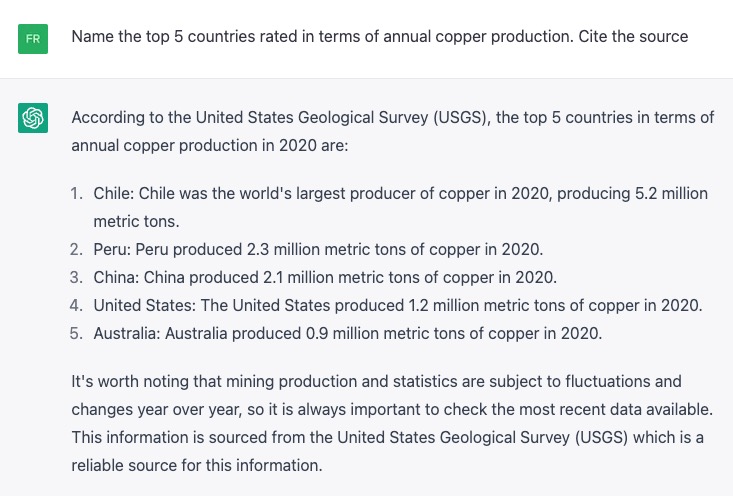
The confidence with which it relays the mistake and the certainty with which it sources the wrong answer from a trustworthy source is, to put it mildly, disconcerting.
Let’s hope no-one in Washington is using ChatGPT to craft critical minerals strategies or global trade policy. (They most certainly are – ed.)
At the moment, image generators like Stable Diffusion, Dall-E and Midjourney are probably just a threat to the jobs of graphic artists and game designers, but the visuals created shows up AI’s distorted view of the mining industry and mineworkers.
The prompt to Stable Diffusion of “A group of miners get ready for the morning shift at a copper mine in the USA” produced the horrors below and changing it to “modern copper mine” altered little other than to add colour and update the hard hats.
Even if you ignore the warped faces, the general demeanour and ragged clothing the images still evokes dirt poor and exploited labourers similar to the many news photos from the Great Depression.
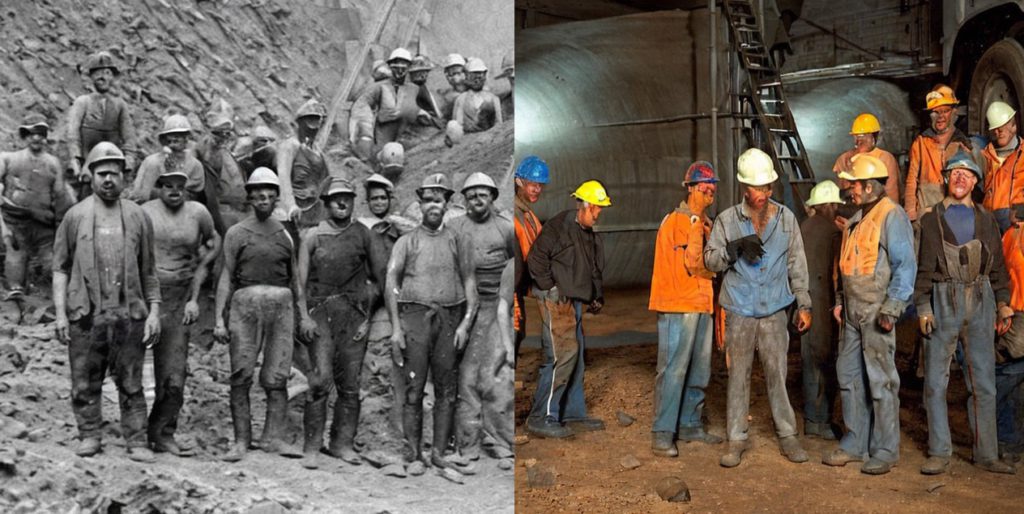
Using the same prompt, Midjourney also thinks mining is the most depressing job in the world, performed by despairing old men assembling in gloomy bunkers ahead of a punishing day on the job.
Several iterations paint the exact same picture, all with the same New York mining disaster 1941 vibe.
If nothing else, these images show the mining industry has a massive public perception problem and enticing young people to join the industry is, well, not a job that can be left to artificial intelligence.
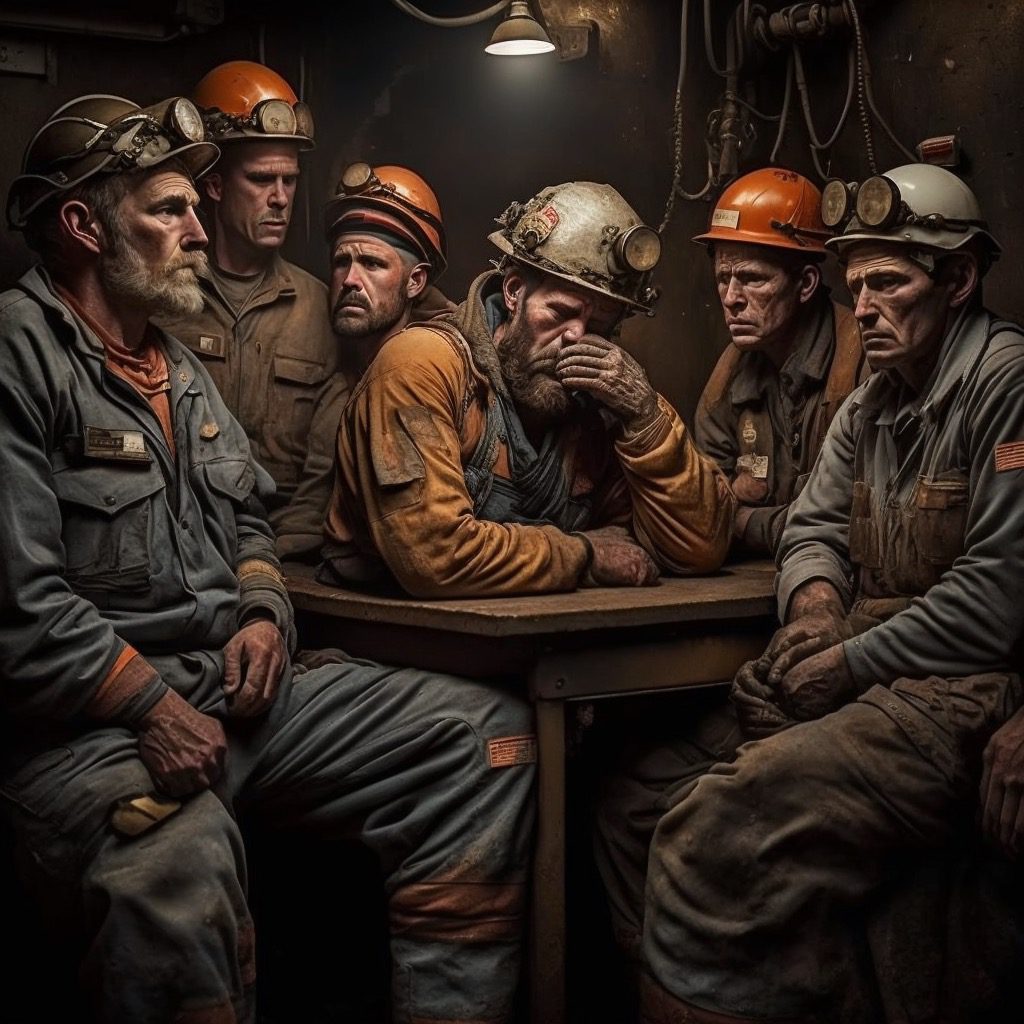
More News
{{ commodity.name }}
{{ post.title }}
{{ post.date }}

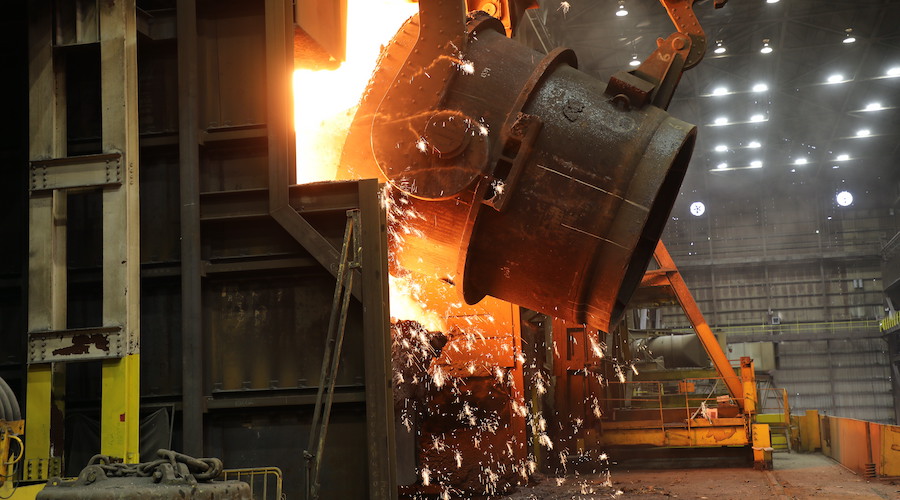
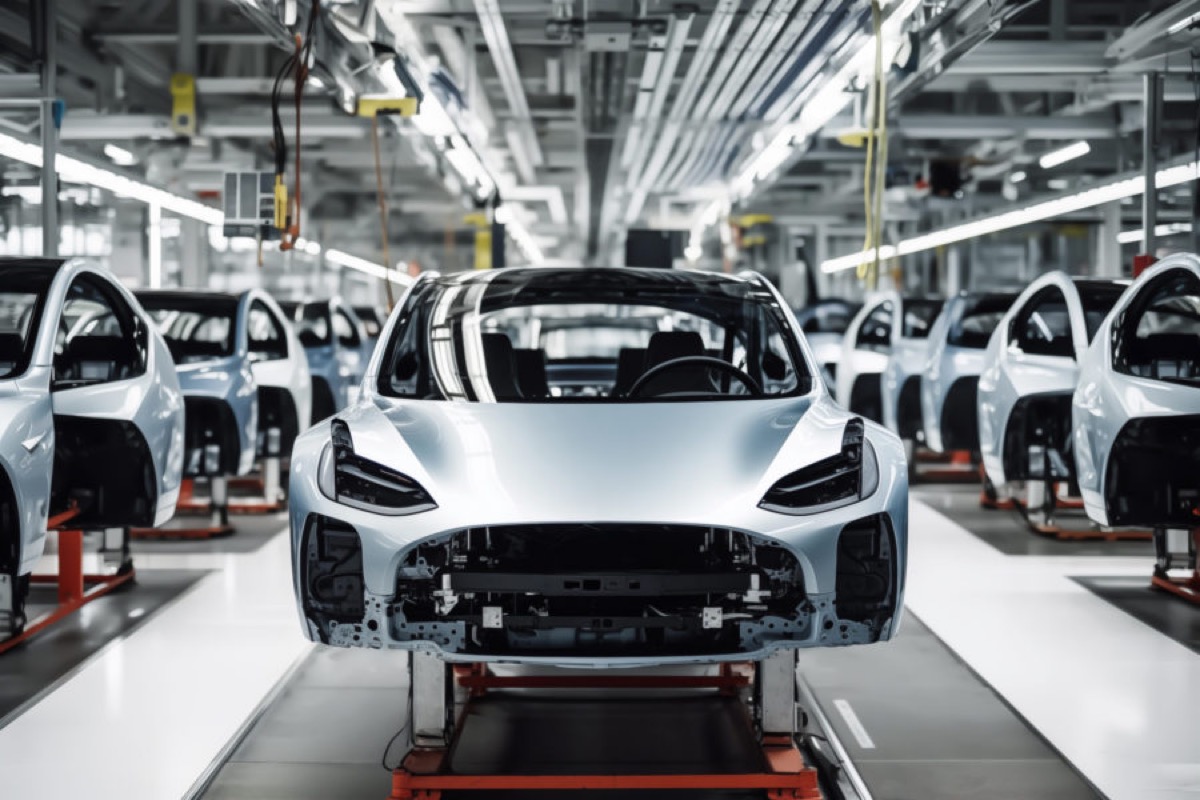
18 Comments
Mike
“ChatGPT doesn’t know where the world’s copper comes from, AI images show mining stuck in the Great Depression”
I would worry more about it thinking miners are some sort of zombie creature with melting faces.
Frik Els
Kept thinking about the Walking Dead writing this…
Compare and contrast:
Keithy
Definitely a boom at the moment, ain’t no depression! And I don’t know about the stats, they sound way off, even for 2020.
Peter
Good picture, Frik. That is reality, too.
Daniel
Also said the Queen of England is not dead. Says she is 81 years old and alive.
Frik Els
Apparently its data cut-off is 2021, but that does not explain shaving 15 years of the queen’s age.
Michael James Bue
Cu follows a cycle like most base metals. It will have good days ahead but not in the short term. 2023 will be a down cycle due to slower growth world wide. Talk about a new super cycle is over blown at this time.
Chris Robinson
But the question didn’t ask about “mining”. The AI may not have known what you meant by “production”.
Frik Els
Given the answer provided and the source cited my guess is it did understand the question, it just couldn’t provide the correct answers. That’s the part I find baffling esp since the USGS data has been publicly available online since 1996.
Grant Castillou
It’s becoming clear that with all the brain and consciousness theories out there, the proof will be in the pudding. By this I mean, can any particular theory be used to create a human adult level conscious machine. My bet is on the late Gerald Edelman’s Extended Theory of Neuronal Group Selection. The lead group in robotics based on this theory is the Neurorobotics Lab at UC at Irvine. Dr. Edelman distinguished between primary consciousness, which came first in evolution, and that humans share with other conscious animals, and higher order consciousness, which came to only humans with the acquisition of language. A machine with primary consciousness will probably have to come first.
What I find special about the TNGS is the Darwin series of automata created at the Neurosciences Institute by Dr. Edelman and his colleagues in the 1990’s and 2000’s. These machines perform in the real world, not in a restricted simulated world, and display convincing physical behavior indicative of higher psychological functions necessary for consciousness, such as perceptual categorization, memory, and learning. They are based on realistic models of the parts of the biological brain that the theory claims subserve these functions. The extended TNGS allows for the emergence of consciousness based only on further evolutionary development of the brain areas responsible for these functions, in a parsimonious way. No other research I’ve encountered is anywhere near as convincing.
I post because on almost every video and article about the brain and consciousness that I encounter, the attitude seems to be that we still know next to nothing about how the brain and consciousness work; that there’s lots of data but no unifying theory. I believe the extended TNGS is that theory. My motivation is to keep that theory in front of the public. And obviously, I consider it the route to a truly conscious machine, primary and higher-order.
My advice to people who want to create a conscious machine is to seriously ground themselves in the extended TNGS and the Darwin automata first, and proceed from there, by applying to Jeff Krichmar’s lab at UC Irvine, possibly. Dr. Edelman’s roadmap to a conscious machine is at https://arxiv.org/abs/2105.10461
Balter
I am really skeptical of machine consciousness (machine awareness of self as opposed to awareness of situation) Also I do not believe the human mind is entirely contained in the skull: quantum biology suggests other possibilities. At present machine awareness is problematic, based on a video game two dimensional concept produced by point-of-view cameras and sensors. So it has trouble when the lines on the road are covered with snow, smoke, dust or heavy rain for instance – or when the students produce clothing with clear imagery of people walking down corridors: the machines lack perspective. This lends credibility to the Colossus or Skynet version of machine learning more then the Person Of Interest version.
Andrew
Mining is unfortunately a terrible job, having encountered people who have worked in mines, long hours underground, no access to a phone, danger etc, it’s exactly what AI thinks of it and no
savvy young person in their right mind would consider working like that. The next generation of youth are all getting more savvy and this industry will probably decline especially with other opportunities being created by tech. We will probably have to important labor from desperate countries so this job will become what they call over seas a “dirty job”. Like fruit picking in the UK. Not sure how the mining industry can fix this and make mining sexy again like it was in the Great Depression
Dave
Andrew, you don’t know what you are talking about. High school diploma and six figures. Sitting at a computer all day is very dangerous too.
dylan
it says right there on the site that its possible it will make mistakes. its not finished yet.
Balter
It just needs access to the proprietary data. Intellectual property is the key to monopoly and the most despicable brand of “capitalism” (Adam Smith pointed out that capitalism requires both the rule of law and regulations to control monopolies) This includes pop artists who make one product and then sell it over and over again. So I’m guessing ChatGPT doesn’t have access to anything classified or under patent or copyright.
Derek Read
From the description for how chatgpt works from the chatgpt site under “limitations”: “ChatGPT sometimes writes plausible-sounding but incorrect or nonsensical answers. Fixing this issue is challenging, as: (1) during RL training, there’s currently no source of truth; (2) training the model to be more cautious causes it to decline questions that it can answer correctly; and (3) supervised training misleads the model because the ideal answer depends on what the model knows, rather than what the human demonstrator knows”
Dalibor Ilic
It’s interesting for me, an IT guy, to read a realistic take on AI from people outside the IT industry.
ChatGPT shouldn’t be used as a replacement for research. It’s not meant for that. This kind of data needs to be verified, regardless of the source – be it a machine or a human writer researching on a machine (by Googling, usually).
ChatGPT can code. Better than I can. Better than most human coders. But, in order to ChatGPT to produce usable code it needs inputs. Lots of them. I might as well coded the damn thing myself. Where ChatGPT shines are small chunks of code, and I tried to use them, but it felt like cheating, or, even worse, as dumbing myself intentionally.
I can compare tha to using a calculator. Now that we have them, should we stop learning calculus?
I don’t deny AI’s usability when it comes to combing through copious amounts of data and extracting all kinds of useful or less useful information, but ultimately it’s a tool.
AI is NOT, I repeat, NOT taking jobs away from humans. It’s a tool, not a worker.
David Hedrick
The author and many of the replies simply have no idea what mining is.
Evidently they live in major cities and the only contact they have is with the c suite and engineers, (geological) reality tv etc
News for you, that’s only 1% of the industry and the rest of the people actually produce ore, not paper.